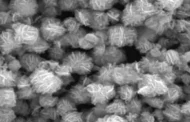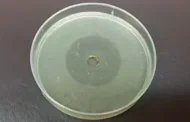NanoMicrobiol NanoBiotechnol, 2023 (1), 202315
DOI:
Review
Clinical trial studies on silver nanoparticles
Mahboubeh Bagheri
Mehr Social Security Organization Hospital, Borazjan, Iran
* Correspondence: bagherim@sums.ac.ie
Abstract
Silver ions and silver complexes have been used as potent antimicrobial agents from ancient time. In recent decades, silver nanoparticles (AgNPs) have emerged as a novel form of ancient antimicrobial element. Our knowledge about this novel form of silver was so developed that we take it to the clinical trial studies. This review is about to provide some data about applications of AgNPs in clinical trials.
Keywords: Bone cement; Catheters; Implants; Silver nanoparticles; Wound dressing
1 Introduction
For the last 5,000 years, many ancient civilizations such as Greeks, Romans, Egyptians and Iranians have used silver in various ways to store food products. The use of silverware for the storage of food and beverages has been common throughout the world in ancient times, most likely due to ancient civilizations’ awareness of the antimicrobial properties of silver. Also, the therapeutic properties of this metal and other metals have been clear to ancient humans. Silver ions were identified as potent antimicrobial compound and were employed by physicians for treatment of ulcers, wounds, and burns (1). Ancient physicians believed that silver dos not only prevent infections but also can promote wound healing process. For instance, about 69 BCE the Roman pharmacopeia suggested for using silver nitrate as medicine (2).
With the arrival of antibiotics in the medical and pharmaceutical world, the use of silver ions became obsolete due to problems such as discoloration in the skin of the treated position. In recent years, with the occurrence of antibiotic resistance in microbial strains and human inability to treat some infections such as burn infections and the prohibition of antibiotics in commercial products, again silver came to spotlight (3). Of course, a new form of it, silver nanoparticles. Silver nanoparticles are nanoscale structures formed by the bonding of silver atoms together (metal bonding). In general, metal nanoparticles have much less toxicity than metal ions (2, 3), but a comparative study between silver nitrate, silver chloride and silver nanoparticles has shown that silver nanoparticles have the highest antibacterial power (4). Therefore, it is tried to use metal nanoparticles instead of metal ions. Silver nanoparticles have very strong antimicrobial properties and this feature is widely used in pharmaceutical and other commercial products (5-7). Now silver nanoparticles are in the list of FDA approved compounds to be used in pharmaceutical products (8).
It has been shown that silver nanoparticles can develop oxidative stresses against microorganisms (9). Silver nanoparticles can release silver ions which are powerful oxidants. Silver ions are believed to interact with four major components of the bacterial cell to produce antibacterial effects including cell wall peptidoglycan, plasma membrane, bacterial DNA, and bacterial proteins, especially enzymes involved in the process of vital functions such as electron transfer chains (4, 10). On the other hand, silver nanoparticles can act as a catalyzer for the formation of reactive oxygen species (ROS) that are so toxic for microbial cells (11). Our knowledge about silver nanoparticles is so great that even data from clinical trial studies are available for this valuable novel material. Data from clinical trial studies will play a key role in strategic health policies. Hence in the current paper a short review on the applications of silver nanoparticles in clinical trial studies is provided that can be unique in terms of study approach.
2 Implants
Implants are a major risk factor for nosocomial infections during medical interventions. In general, two groups of implants are used in medical interventions. Implants that are placed completely in the patient’s body and implants that are part of the patient’s body outside and in contact with the outside environment. First-class implants, such as artificial heart valves, can become infected during the implantation process and require preventive antibiotic treatment during the first few days after surgery. In contrast, the second group, such as vascular and urinary catheters, are prone to bacterial colonization due to constant contact with the external environment (4). To overcome the major challenge with implants we need to develop antimicrobial implants with antimicrobial coating. A suitable antibacterial coating should have characteristics such as long-term activity, high level of bactericidal and bacteriostatic activity, broad spectrum of action, biocompatibility and low toxicity to humans. In addition, it must be inexpensive and recyclable. For cardiovascular applications, the antibacterial coating should be compatible with the blood to prevent thrombosis (4).
2.1 Cardiovascular implants
In 1998, an artificial silicone heart valve coated with silver metal called silzone was designed to reduce the prevalence of endocarditis following valve replacement surgery and was used in clinical trials (12). The rationale for using silver was to prevent bacterial colonization on the silicone valve, and thus reduce inflammation of the heart. Advanced toxicity tests showed acceptable biocompatibility of these valves, but four years after the start of the trial due to the high prevalence of extra valvular leakage in patients, these valves shrunk. Research has shown that inhibition of normal fibroblast function and increased sensitivity are the reasons for the failure of trials (13). As a conclusion, the use of silver in the coverage of cardiovascular equipment was stopped. Silver nanoparticles are currently considered as a suitable alternative to safe and non-toxic antibacterial coatings for medical equipment (4).
A new nanocomposite based on diamond-like carbon with silver nanoparticles dispersed in a matrix has been synthesized for blood-compatibility properties an was used as a surface coating for cardiovascular equipment such as valves and stents. Platelet adhesion studies showed a reduction in platelet binding to the nanocomposite surface. Platelets that adhered to the surface were also randomly isolated, indicating the anti-thrombotic properties of the nanocomposite (14).
2.2 Central vascular catheters
There are various policies in the field of research on the use of polymers inoculated with silver nanoparticles as antibacterial agents to delay the growth of biofilm on the surface of catheters (33). The most common of these is that polyurethane, now known as plastic catheters, is modified by silver nanoparticles. Plastic catheter tubes can be coated with a layer of silver nanoparticles to create effective antibacterial catheters (15). In vitro studies have shown effective inhibition of biofilm growth and long-term effect for at least 72 hours. A 10-day in-body study in mice proved that catheters coated with silver nanoparticles were non-toxic (16).
2.3 Neurosurgical catheters
Catheters are used in neurosurgery to remove excess cerebrospinal fluid, which can increase intracranial pressure and brain damage. These types of catheters can also be permanent or temporary, both of which are prone to bacterial infection, and the infection can quickly spread to the brain and surrounding meninges. The bacteria involved are mainly Staphylococcus aureus, Staphylococcus epidermidis, and Pseudomonas aeruginosa (4).
Silver nanoparticles are rapidly stabilizing in the daily use of neurosurgery because their strong antibacterial properties and non-toxicity can reduce the prevalence of bacterial infections and other complications during surgery. For example, neurosurgical catheters containing silver nanoparticles were developed to reduce catheter infections. In vitro studies have shown long-term release of silver ions that lasted for at least 6 days, plus a significant reduction in S. aureus growth (17).
In a pilot clinical study, external ventricular drainage catheters containing silver nanoparticles were used to show that silver nanoparticles were present in patients with acute obstructive hydrocephalus (in which ventricular obstruction causes ventricular dilation and increased intracranial pressure). They are useful in preventing ventricular inflammation caused by catheters. In this study 19 patients received catheters containing silver nanoparticles and the control group (n = 20) received conventional catheters. In the control group, five people were positive for cerebrospinal fluid culture, indicating catheter-induced ventricular inflammation. In the group that received catheters containing silver nanoparticles, no case of catheter-induced ventricular inflammation was observed and all cerebrospinal fluid cultures were negative. The study showed that silver nanoparticles are potentially useful in preventing catheter-induced ventricular inflammation and are acceptable for in-body use in humans, and there have been no reports of toxicity (18).
3 Bone cement
Silver nanoparticles are used as an antibacterial additive in polymethyl methacrylate bone cement (37). Bone cement is used for the secure connection of joint prostheses, for example in pelvic and knee replacement surgery. The prevalence of infection in all joint replacements is high, ranging from 1 to 4% (38). The use of antibiotic-based joint cements reduces the prevalence of infection by 0.4 to 1.8%, but relying on antibiotics is undesirable because bacterial resistance can occur rapidly. Poly (methyl methacrylate) joint cement containing silver nanoparticles due to its multiple mechanism of action can reduce the prevalence of bacterial resistance and in vitro studies have shown effective antibacterial activity and low cytotoxicity. Strong antibacterial action against methicillin-resistant S. epidermidis and S. aureus and delayed biofilm growth has been observed. Bone cement containing silver nanoparticles in rat fibroblasts and human osteoblasts did not show cytotoxicity, indicating acceptable biocompatibility (37).
4 Wound dressing
Wound dressings containing nanocrystalline silver have been commercially available for nearly a decade (such as ActicoatTM) and are currently in the clinic for the treatment of various wounds such as burn wounds, toxic epidermal necrosis, Stevens-Johnson syndrome, wounds chronic and pemphigus (19). Typical dressings consist of two layers of polyethylene mesh that form a sandwich around a layer of polyester gas. The typical nanocrystalline coating is 900 nm thick and the size of the nanocrystals is 10 to 15 nm and they are applied on the polyethylene layer (25).
Randomized clinical trials have investigated the excellent wound healing properties of nanocrystalline silver dressings over conventional gauze and silver sulfadiazine dressing regimens in the treatment of burns. In one of these trials, the efficacy of nanocrystalline silver against silver sulfadiazine was evaluated on 166 different burn wounds in 98 patients (39). Nano-crystalline silver dressing dramatically reduced wound healing time by an average of 3.35 days and increased bacterial clearance of infectious wounds. No side effects were observed for the dressings. Another trial looked at silver nanoparticles in the treatment of second-degree burns. 191 patients were divided into groups treated with dressings containing silver nanoparticles, 1% sulfadiazine silver cream or Vaseline. The results clearly showed the superiority of dressings containing silver nanoparticles in reducing the healing time of superficial burn wounds, but there was no difference in the healing of deep burn wounds between silver nanoparticles with 1% silver sulfadiazine (40). It is suggested that silver nanoparticles accelerate epithelial regeneration but do not accelerate other stages of wound healing that lead to the formation of new tissue, such as angiogenesis and cell division (25).
References
Sim W, Barnard RT. Antimicrobial silver in medicinal and consumer applications: A aatent review of the past decade (2007⁻2017). Antibiotics (Basel, Switzerland). 2018;7(4):93.
- Ebrahiminezhad A, Raee MJ, Manafi Z, Jahromi AS, Ghasemi Y. Ancient and Novel Forms of Silver in Medicine and Biomedicine. Journal of Advanced Medical Sciences and Applied Technologies. 2016;2(1):122-8.
- Nakhaeitazreji S, Hadi N, Taghizadeh S-M, Moradi N, Kakian F, Hashemizadeh Z, et al. Green Synthesized Iron-Coated Silver Nanoparticles: Economic Bimetallic Nanoparticles Potential Against Methicillin-Resistance Staphylococcus aureus. Mol Biotechnol. 2023.
- Chaloupka K, Malam Y, Seifalian AM. Nanosilver as a new generation of nanoproduct in biomedical applications. Trends Biotechnol. 2010;28(11):580-8.
- Fernandez CC, Sokolonski AR, Fonseca MS, Stanisic D, Araújo DB, Azevedo V, et al. Applications of silver nanoparticles in dentistry: advances and technological innovation. Int J Mol Sci. 2021;22(5):2485.
- Barkat MA, Harshita F, Beg S, Pottoo FH, Garg A, Singh SP, et al. Silver nanoparticles and their antimicrobial applications. Current Nanomedicine. 2018;8(3):215-24.
- Arya G, Sharma N, Mankamna R, Nimesh S. Antimicrobial silver nanoparticles: future of nanomaterials. Microbial nanobionics: Springer; 2019. p. 89-119.
- Sood R, Chopra DS. Regulatory approval of silver nanoparticles. Applied Clinical Research, Clinical Trials and Regulatory Affairs. 2018;5(2):74-9.
- Quinteros M, Aristizábal VC, Dalmasso PR, Paraje MG, Páez PL. Oxidative stress generation of silver nanoparticles in three bacterial genera and its relationship with the antimicrobial activity. Toxicol In Vitro. 2016;36:216-23.
- Yin IX, Zhang J, Zhao IS, Mei ML, Li Q, Chu CH. The antibacterial mechanism of silver nanoparticles and its application in dentistry. Int J Nanomedicine. 2020:2555-62.
- Xiu Z-m, Zhang Q-b, Puppala HL, Colvin VL, Alvarez PJ. Negligible particle-specific antibacterial activity of silver nanoparticles. Nano Lett. 2012;12(8):4271-5.
- Grunkemeier GL, Jin R, Starr A. Prosthetic heart valves: Objective Performance Criteria versus randomized clinical trial. The Annals of thoracic surgery. 2006;82(3):776-80.
- Jamieson WR, Fradet GJ, Abel JG, Janusz MT, Lichtenstein SV, MacNab JS, et al. Seven-year results with the St Jude Medical Silzone mechanical prosthesis. The Journal of thoracic and cardiovascular surgery. 2009;137(5):1109-15.e2.
- Andara M, Agarwal A, Scholvin D, Gerhardt RA, Doraiswamy A, Jin C, et al. Hemocompatibility of diamondlike carbon–metal composite thin films. Diamond Relat Mater. 2006;15(11):1941-8.
- Samuel U, Guggenbichler JPP. Prevention of catheter-related infections: the potential of a new nano-silver impregnated catheter. Int J Antimicrob Agents. 2004;23:75-8.
- Roe D, Karandikar B, Bonn-Savage N, Gibbins B, Roullet JB. Antimicrobial surface functionalization of plastic catheters by silver nanoparticles. J Antimicrob Chemother. 2008;61(4):869-76.
- Galiano K, Pleifer C, Engelhardt K, Brössner G, Lackner P, Huck C, et al. Silver segregation and bacterial growth of intraventricular catheters impregnated with silver nanoparticles in cerebrospinal fluid drainages. Neurol Res. 2008;30(3):285-7.
- Lackner P, Beer R, Broessner G, Helbok R, Galiano K, Pleifer C, et al. Efficacy of silver nanoparticles-impregnated external ventricular drain catheters in patients with acute occlusive hydrocephalus. Neurocritical care. 2008;8(3):360-5.
- Boroumand Z, Golmakani N, Boroumand S. Clinical trials on silver nanoparticles for wound healing. Nanomedicine Journal. 2018;5(4):186-91.





